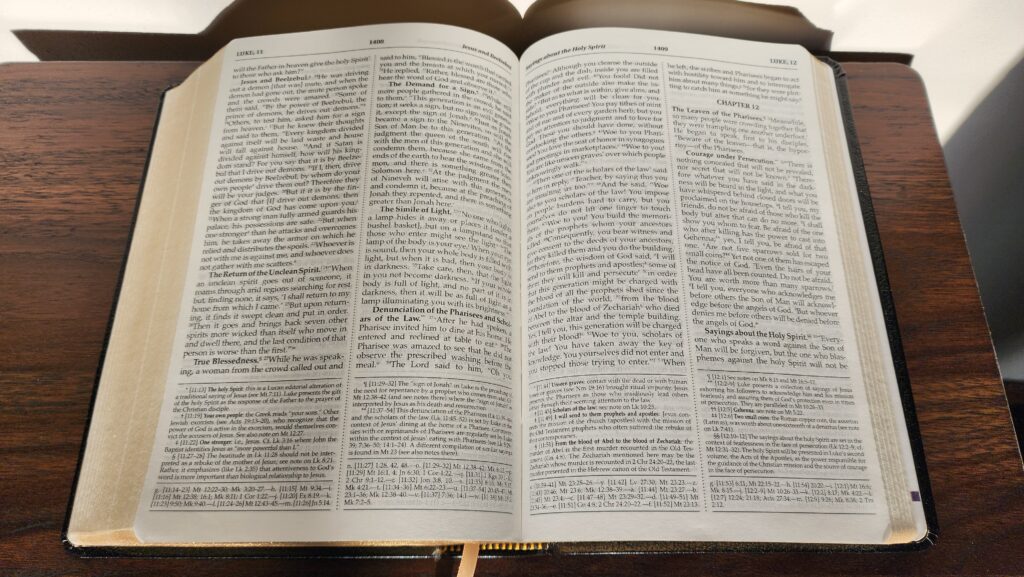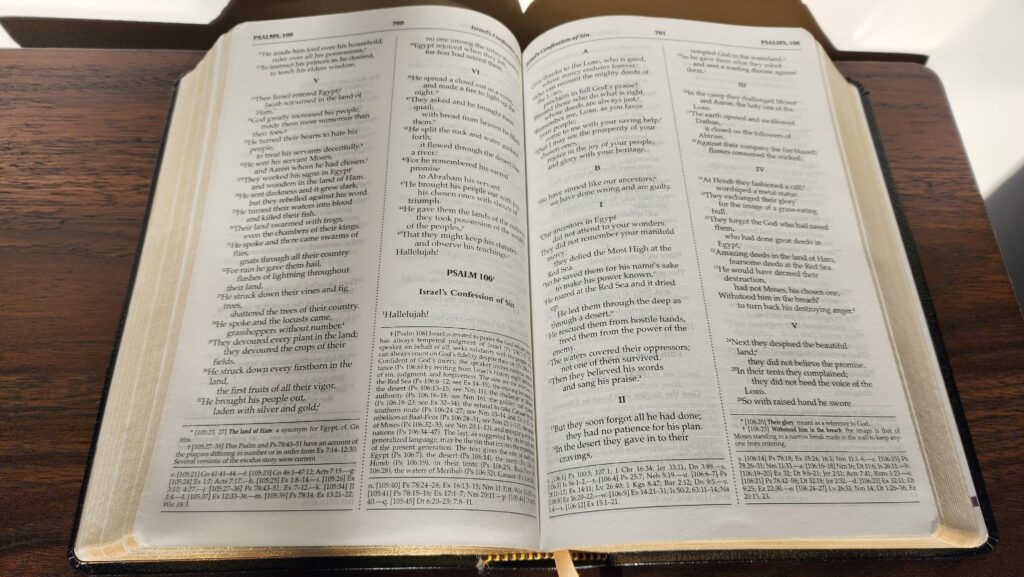
Tan Books was recently offering their black leatherette NABRE for a sale price of $20 (plus shipping). This Bible has been on the market for several years, but I never purchased a copy. Timothy hosted a guest review in 2011 on his blog. I decided to take advantage of the sale last week and received my copy a few days ago.
Right away, I was surprised to see gold lettering on the front and spine of the Bible. Every other photo of this edition I’ve seen online has shown blind stamped text on the front and spine. This video on YouTube also shows the blind stamping. The cover also looks like a different material compared to photos I’ve seen online. My copy feels a lot like the bonded leather used on the black bonded leather Liturgy of the Hours set from Catholic Book Publishing Corporation. It doesn’t have much thickness.
Physical Construction
The Bible features a sewn binding, a single gold ribbon marker, and good quality gold gilding on the page edges. Many of the pages were stuck together at the corners due to the gilding when I first received it, so I spent some time separating pages. There were a few scratches on the gilding, but overall it is good quality.
This bible is nearly identical in length, width, and thickness compared to the Personal Size New Catholic Bible which I recently reviewed. Its length and width are also similar to the personal size NRSVue with Apocrypha from Zondervan which I reviewed a couple of years ago, but the NRSVue is notably thinner because it doesn’t have any explanatory notes.


Page Layout and Typesetting
This is a black-letter edition with a simple and clear font and comfortable line spacing for the biblical text. The footnotes are printed in a much smaller font compared to the biblical text. The font style of the footnotes is also simple and clear, so despite the small letters, they are legible for me. I’m not at the age where I need reading glasses, though. These footnotes will definitely pose a challenge for readers who have trouble with small print. I think this is a reasonable layout for a personal size bible. Since the NABRE notes are required to be printed in every edition, it makes sense to make them smaller in order to keep the biblical text as readable as possible in a relatively small form factor.
The paper is also good quality in this edition. It is not quite as opaque as the paper in the Personal Size New Catholic Bible, but I would classify it as above average in opacity. There is a small amount of ghosting, but it is very well-controlled.
Why Buy a NABRE in 2024?
Since the USCCB is currently in the late stages of producing a revised New Testament for the New American Bible (due to be released in 2025), why bother buying a copy of the NABRE now? For many people, it won’t be worthwhile. In my case, I’ve been gradually coming around to appreciating the NABRE after spending many years reading the RSV-2CE, the REB, and the NRSV as my primary translations. Even though I’ve been annoyed by its stilted style in the New Testament, I’ve come to appreciate its commitment to representing the Greek the way it really is (without smoothing out all of its grammatical imperfections) and its usefulness for study. I fully expect to purchase the updated translation when it is released, but I’d like to have a few copies of the NABRE for reference and study which I can use for years to come.
Conclusion
At the $20 sale price I purchased it for, this edition easy to recommend if you like the NABRE. In truth, this is what I wish Catholic Book Publishing Corporation would do with their Personal Size New Catholic Bible: a black-letter edition with good typesetting, sewn binding, good paper, good gilding, and most of all no glossy color inserts.



One thing I have great appreciation to the NABRE for, which I wasn’t aware of until discovering R. Grant Jones’s charts years back, was that it utilized the LXX/DSS/etc. against the Masoretic Hebrew to a greater extent than any other English translation of the Bible (that is, any that wasn’t literally a translation of the LXX), with the NRSV and REB coming in relatively distant second and third positions behind it. I hope the 2025 NAB maintains that commitment because it’s quite useful to have a mainstream translation that is willing to take a less conservative approach to the MT, something the ESV, CSB, NKJV, NASB, LSB, and so forth are so unwilling to do.
I won’t be first in line for the 2025 NAB, but only because I’m hoping to snag a top-quality “forever” copy out of the gate, which means I’ll be praying Oxford or someone similar gets ahold of it. My pie-in-the-sky dream would be someone like Schuyler getting to do a print of it.
It’s strange that the photo for that $20 Bible on Tan Books is showing a different Bible. They should really update that photo so people know what they’re going to get. I already have a NABRE Bible that I like for this translation:
https://catholicbibles.blogspot.com/2015/11/usccb-publishing-nabre-personal-edition.html
I’m looking forward to the new NAB translation coming out as early as 2025.
Just wanted to clarify something. The next edition of NABRE is absolutely not being released in 2025 (which is next year). They haven’t event settled on a name for it, other than that it will not be called NABRE. The approval process has not even begun on this, no USCCB vote has been held on the approval of this new translation. There is a vote scheduled for November of thus year that pertains to those portions of the new translation to be used by the LOTH 2nd Edition, but that vote does not pertain to the whole translation, just whatever is being used in the new LOTH. There is presently no date for a vote on the new Bible translation. Moreover, it would be at least six months for the Holy See to grant approval after a vote and approval is given by the USCCB. After approvals by the USCCB and Holy See, there would be at minimum a year of editing done in preparation for publication. This Bible project is not merely a revision of the 1986 New Testament, it’s a whole new Catholic translation of the NT and a massive overhaul and redux of the notes. On top of that, they are sifting through the OT for various revisions. All the while, a committee is reading the entire Bible line by line to determine suitability for proclamation.
The LOTH 2nd Edition is currently on course to be published in 2026, after multiple serious delays. The new Bible may or may not make it in time to coincide, but there is no possibility of a 2025 release date, that is not even in the cards.
I hate this whole situation far more than you do and I cannot put into words how much I was hoping to have this Liturgical Bible in my hands next year. To have those hopes dashes like this is killing me. Figuratively and literally, as I could be age 40 or older (assuming a 2026-2027 release date) by the time this Bible makes it to press. Let’s pray this endeavor results in the best New Testament translation shy of the original Greek copies.
Ha! I’m 45 so I guess I should pray it comes out before I’m 50! I have the didache nabre as my main bible. It’s a “brick”, big and heavy, but it’s always my go too.
I haven’t been following the USCCB’s plans carefully, so the question I’m about to raise might simply stem from ignorance of the timeline. Is it possible that the updated NAB (whatever it ends up being called) will be approved by the bishops before the LOTH and the Lectionary? Theoretically, the new Bible could be granted a rescript by the USCCB without requiring approval from Rome, correct? The Dicastery for Divine Worship will need to confirm new liturgical books (Lectionary, LOTH), but bishops’ conferences may approve Bible translations on their own.
In the past, it has been quite common for NAB updates to be released well before they are incorporated into new liturgical books (for example, the 1986 New Testament was published many years before the Lectionary for Mass was revised and approved). The NABRE was approved and published even though the revised Old Testament was never incorporated into a revised lectionary. Maybe it will be different this time, since the goal is to have a liturgical Bible which will match the lectionary and LOTH.
Until the NCCB formally announces that the new edition of the NAB will be delayed indefinitely (“2025? More like 2075!”) we cannot say with assurance what will, and will not, happen.
It appears that the sale has ended. Perhaps it was only in April?
Oh, that’s unfortunate. I bet you’re right that it ended in April. I updated the post to clarify that the sale is no longer happening.
It looks like the burgundy leatherette version of the St. Benedict NABRE is available for just under $30 on Amazon right now, so good prices are still out there:
https://www.amazon.com/NABRE-American-Revised-Premium-Ultrasoft/dp/1618900617/
We can definitively rule out a 2025 release. It is absolutely not happening. A vote of by the bishops of the USCCB on the translation itself (not the bits and pieces used by any other project like the new breviary) has not even been scheduled. Without a vote scheduled for this year, it is absolutely not coming in 2025.
Even if you wish to believe an approval by the Vatican is not necessary (let’s be clear, the Vatican will need to approve this new translation), so let’s just cut out six months of the timeline and argue a USCCB vote alone is sufficient for publication. Even if you believe that, there is still a bare minimum of 1 year needed for editing. So a vote to approve, followed by a minimum of a year for editing to prepare for publication.
Just wanted to add another thing, the CBA has not been involved in this Bible project for several years. Let me explain why that is. Originally, this translation project was going to be a revision of the 1986 NAB NT (itself a revision), that was the original intention. The editorial team working for the CBA laboured for years under this goal: revising the 1986 NT where necessary. The USCCB changes the aims of this project partway through, it was no longer going to be a revision but an entirely new translation. Once it was decided that this would be a wholly new translation and not just a revision, the USCCB took over the project directly and the CBA was no longer involved.
Is there any update on this situation? Josh, you seem knowledgeable on the topic, where are you getting this information, I’d like to follow the progress as well.